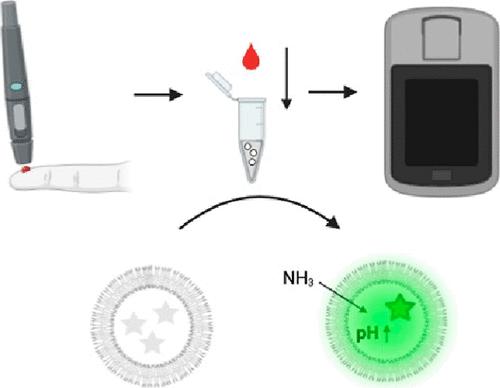Development of a Polymersome Blood Ammonia Assay Coupled with a Portable Near-Infrared Fluorometer
IF 3.8
Q2 BIOCHEMISTRY & MOLECULAR BIOLOGY
引用次数: 0
Abstract
Ammonia is a key biomarker in inborn and acquired liver disease. As clinical point-of-care blood ammonia assays are lacking, we developed a polymersome formulation for point-of-care blood ammonia sensing combined with a portable fluorometer. A pH-sensitive near-infrared (NIR) fluorescent dye was identified, which showed a strong fluorescence increase at acidic pH values. Building on reports on ammonia-selective PS-b-PEG polymersomes, these polymersomes were loaded with the NIR dye. These NIR fluorescent polymersomes sensed ammonia in a clinically relevant range in ammonia-spiked fresh whole blood with high linearity (R2 = 0.9948) after 5 min using a conventional tabletop plate reader. Subsequently, the assay was tested with a portable fluorometer. An ammonia-dependent fluorescence increase was detected in ammonia-spiked fresh mouse blood after 5 min using the portable fluorometer. The NIR dye-loaded PS-b-PEG polymersomes rapidly sensed ammonia with high linearity in whole blood. This assay was successfully combined with a portable fluorometer and only required 3 μL of blood. These findings motivate a further development and clinical translation of this point-of-care blood ammonia assay.

开发与便携式近红外荧光测定仪相结合的聚合体血氨测定法
氨是先天性和后天性肝病的关键生物标志物。由于缺乏临床护理点血氨检测方法,我们开发了一种结合便携式荧光计的护理点血氨传感聚合物组配方。我们发现了一种对 pH 值敏感的近红外(NIR)荧光染料,该染料在酸性 pH 值时荧光强烈增强。根据有关氨选择性 PS-b-PEG 聚合体的报道,这些聚合体中添加了近红外染料。这些近红外荧光聚合体使用传统的台式平板阅读器,在 5 分钟后在氨添加的新鲜全血中感应临床相关范围内的氨,线性度高(R2 = 0.9948)。随后,使用便携式荧光检测仪对该检测方法进行了测试。使用便携式荧光检测仪检测到,5 分钟后,氨加标小鼠新鲜血液中的荧光增加。负载近红外染料的 PS-b-PEG 聚合体能在全血中快速感应氨,且线性度很高。这种检测方法成功地与便携式荧光计结合在一起,而且只需要 3 μL 血液。这些发现推动了这一护理点血氨检测方法的进一步开发和临床应用。
本文章由计算机程序翻译,如有差异,请以英文原文为准。
求助全文
约1分钟内获得全文
求助全文
来源期刊

ACS Bio & Med Chem Au
药物、生物、化学-
CiteScore
4.10
自引率
0.00%
发文量
0
期刊介绍:
ACS Bio & Med Chem Au is a broad scope open access journal which publishes short letters comprehensive articles reviews and perspectives in all aspects of biological and medicinal chemistry. Studies providing fundamental insights or describing novel syntheses as well as clinical or other applications-based work are welcomed.This broad scope includes experimental and theoretical studies on the chemical physical mechanistic and/or structural basis of biological or cell function in all domains of life. It encompasses the fields of chemical biology synthetic biology disease biology cell biology agriculture and food natural products research nucleic acid biology neuroscience structural biology and biophysics.The journal publishes studies that pertain to a broad range of medicinal chemistry including compound design and optimization biological evaluation molecular mechanistic understanding of drug delivery and drug delivery systems imaging agents and pharmacology and translational science of both small and large bioactive molecules. Novel computational cheminformatics and structural studies for the identification (or structure-activity relationship analysis) of bioactive molecules ligands and their targets are also welcome. The journal will consider computational studies applying established computational methods but only in combination with novel and original experimental data (e.g. in cases where new compounds have been designed and tested).Also included in the scope of the journal are articles relating to infectious diseases research on pathogens host-pathogen interactions therapeutics diagnostics vaccines drug-delivery systems and other biomedical technology development pertaining to infectious diseases.
 求助内容:
求助内容: 应助结果提醒方式:
应助结果提醒方式:


